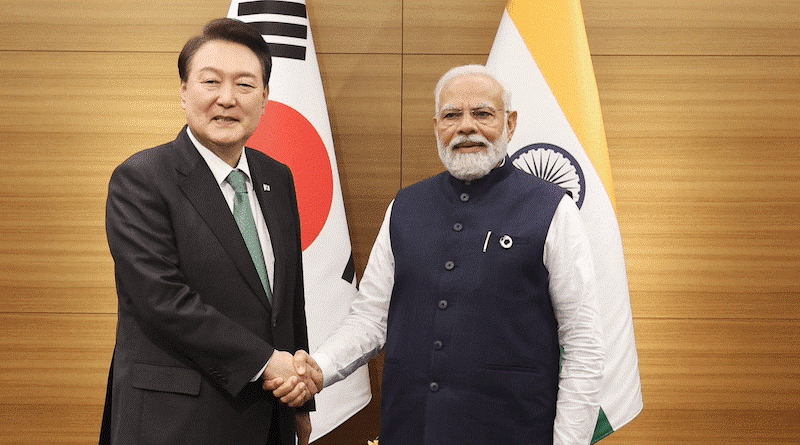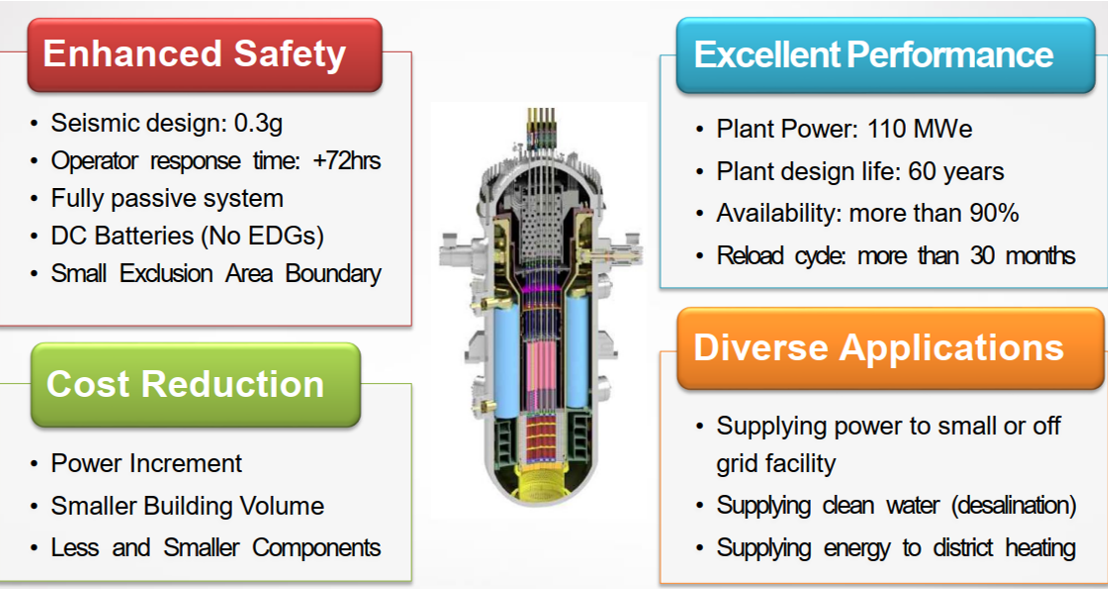50 Years of India-Korea Relations: Enhanced Nuclear Cooperation Next?
This years marks the 50th anniversary of India-Korea diplomatic relationships.
India and South Korea enjoy a longstanding and robust relationship that encompasses various domains such as trade, culture, and strategic partnerships. Over the years, the bilateral ties between the two countries have deepened and diversified, strengthening their cooperation on multiple fronts. India and South Korea have witnessed a substantial growth in their bilateral trade, with both countries actively engaging in sectors like automobiles, electronics, and energy. In 2022, bilateral trade increased to a record high of approximately $28 billion. The two countries aspire to take commerce up to $50 billion by 2030.
Additionally, cultural exchanges have played a pivotal role in fostering people-to-people connections, while defense and security cooperation has been a key aspect of their strategic partnership. With a shared commitment to democracy, innovation, and technological advancement, India and South Korea continue to explore avenues for further collaboration, aiming to establish a mutually beneficial and sustainable partnership in the years to come.
Both countries have been taking steps to deepen and broaden their relationship for more the past ten years. Both are signatories to the Comprehensive Economic Partnership Agreement (CEPA) since 2009. In 2010, the relationship was designated as ‘Strategic Partnership’ by the two governments which was later elevated to the level of ‘Special Strategic Partnership’ in 2015. India’s Act East Policy (2015) during Indian Prime Minister Narendra Modi’s visit to Korea and South Korea’s New Southern Policy (2017) have a lot of convergence in terms of their regional priorities.
While New Delhi and Seoul have enhanced their cooperation over the past 5 decades, both must realise that they have much more potential for a comprehensive relationship and this could be in the civil nuclear energy sector.
South Korea's President Yoon Suk Yeol with India's PM Narendra Modi. Photo Credit: India PM Office
Shift in South Korea’s Civil Nuclear Aspirations under Yoon Administration
Following the election of Yoon Suk Yeol as president of South Korea, the Asian powerhouse made a 180-degree turn on its domestic and international nuclear energy approach. President Yoon has called for nuclear power to account for 30 percent of South Korea’s energy generation and wants South Korea to become a major exporter of nuclear equipment and technology. President Yoon has promised to export 10 nuclear plants by 2030. In addition, the new government established the committee for nuclear export strategy promotion in August 2022 .
While much focus has been placed by South Korea on winning nuclear deals in Easter Europe, India could potentially be South Korea's next market for civil nuclear export following the successful construction of 4 APR-1400 reactors in the UAE which was delivered on time and on budget.
India’s Nuclear Energy Plans for Foreign Reactor Technology
With over 7 GWe installed nuclear capacity, 15.7 GWe under construction projects and further 25.8 GWe proposed capacity to be built up, India offers business opportunities across the entire spectrum of plant lifecycle of NPPs. A business potential of USD 125 Billion has been estimated for the projects in pipeline.
While India’s nuclear power program has traditionally relied on indigenous technology, the country in recent times has opened up and is embracing foreign reactor technologies to complement its current fleet. The Russians have constructed several VVER-1000 units at the Kudankulam site while the French are in advanced discussion to have 6 EPR reactors (9.6 GWe) built in Jaitapur. Westinghouse, since 2008 have been talks with the Indians to build 6 units of AP100 at Andhra Pradesh albeit at a slow pace.
South Korea’s APR-1400 Perfect For India
The successful export of APR1400 to UAE coupled with the attainment of EUR Certification of EU-APR and NRC Design Certification of APR1400 for its reactors has increased the export competitiveness of the APR1400 in the international markets.
The positive experience from the APR1400 export to UAE would be received well from the Indian government:
Barakah NPP unit 1 was constructed in 6 years as originally planned
Expected BNPP project cost was $20bn which ended up at $24bn with the increase in cost due to yearly inflation
The Koreans placed a strong emphasis on localisation which is in-line India’s emphasis on Made in India
India’s Growing Interest In SMRs and South Korea’s Efforts to Promote SMR Development
In July 2023, a Korean SMR public-private alliance was formed comprising of 42 entities such as Ministry of Trade, Industry, and Energy, Korea Hydro & Nuclear Power, Export–Import Bank of Korea, SK Inc., Samsung C&T, Daewoo Engineering & Construction. The alliance aims to enhance national competitiveness in the small modular reactor (SMR) sector and plans to establish two working groups—one to work on business development strategies for the use of SMRs and the second to create a basis for systemic development.
Korea is developing two SMR technologies, the SMART100 and the i-SMR
SMART100 (System-integrated Modular Advanced Reactor)
Recently, India’s Minister for Atomic Energy, Dr Jitendra Singh shared that India is taking steps for development of Small Modular Reactors (SMR), with up to 300 MW capacity to fulfill its commitment to Clean Energy transition.
NITI Aayog, the public policy think tank of the Government of India chaired by the Prime Minister is now focusing on scale-up of nuclear capacity in the country through large reactors as well through new generation small modular reactors. Recently, on 16 May 2023 NITI Aayog organized a G20 Summit on Small Modular Reactors . In association with Department of Atomic Energy (DAE), NITI Aayog also released a comprehensive report on “The Role of SMRs in the Energy Transition”, detailing on the technology development, roadmaps , regulatory frameworks and increased private participation in nuclear sector. NITI Aayog considers that energy transition and net zero cannot be possible without nuclear making up a substantial portion of the energy mix.
Current Korean Involvement In Indian Nuclear Sector
In 2019, Hyundai Heavy Industries signed a $49 million deal with Indian firm Powerica to supply emergency generators for nuclear reactors. The generators include 10 units of the 6.3-megawatt HiMsen propulsion system developed by HHI. The units were supplied to Unit 3 and 4 of the Kudankulam nuclear power plant in the southern state of Tamil Nadu.
2011 India-Korea Civil Nuclear Agreement
It is important to note that 12 years ago, India and Korea did have a civil nuclear agreement.
The India-Korea Civil Nuclear Agreement, signed on 18th July 2011, marked a significant milestone in the bilateral relations between India and South Korea. The agreement enabled the two countries to cooperate in the field of peaceful use of nuclear energy, facilitating the supply of nuclear reactors, raw materials, and technological know-how.
Under the agreement, South Korea recognized India as a responsible nation with advanced nuclear technology and committed to assisting India in meeting its rapidly growing energy demands. The pact allowed for the transfer of nuclear technology, including design, construction, and operation of nuclear power plants, as well as the exchange of scientific information and cooperation in nuclear safety and security.
One of the major highlights of the agreement was South Korea's willingness to supply nuclear reactors to India. This represented a significant breakthrough for India as it opened up opportunities for the country to diversify its sources of nuclear technology and reduce its dependence on a few countries.
The agreement also emphasized the significance of nuclear safety and established a framework for cooperation between the two countries in this area. It focused on training and exchange of personnel, sharing of best practices, collaboration in emergency preparedness, and the promotion of nuclear safety culture.
While the export of Korean nuclear reactors to India has to materialize, the current strategic climate of both countries suggests that there is a strong chance for South Korea to build large and/or small reactors in India. In fact there is much more optimism and enthusiasm with the India-Korea Civil Nuclear Agreement as opposed to the US-India Nuclear deal in 2008 which to-date has not yielded much progress in terms of American reactors being built in India.
Win-Win For India And South Korea to Cooperate in Civil Nuclear
With the Indian government keen to add more nuclear capacity (large and small reactors) through both indigenous and foreign technology coupled with South Korea ambitions to export more nuclear reactors, this could be a perfect match for cooperation in the civil nuclear sector. The India-Korea Civil Nuclear Agreement has laid the foundations, it is now time for scaling-up!
India Nuclear Business Platform 2023
The Korean Trade and Promotion Agency (KOTRA) will be hosting a country pavilion at the 4th edition of India Nuclear Business Platform (INBP) meeting in Mumbai this 10-11 October. Over ten Korean companies are expected to showcase their solutions, services and products for the Indian nuclear market. More information on this meeting is available here.




